Archive Report
4th International Materials Education Symposium, 2012
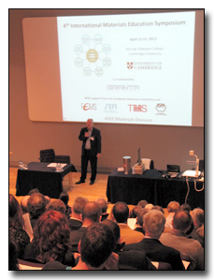 Peter Goodhew (University of Liverpool) welcomes participants to the 4th International Materials Education Symposium, setting the collaborative tone by inviting tweets and post-it-note discussion questions. |
|
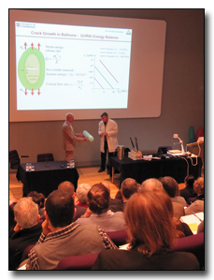 Bill Clyne (Cambridge University) provides an explosive start, and a question: are practical demonstrations work the effort? |
|
 The Symposium booklet contained abstracts from all the presentations and posters, as well as useful local information. |
|
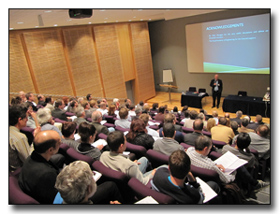 Almost 150 participants packed the lecture room. |
|
 Brian Magee (Queen's University Belfast) giving his excellent talk on inspiring 'industry-savy students': concrete is clearly not 'as dull as its color'! |
|
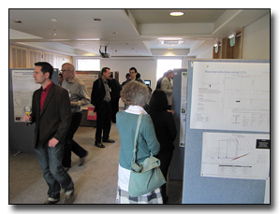 Discussions spilled out into the poster session, with the 'Poster Teasers' highlighting the breadth of research and resources on display. |
|
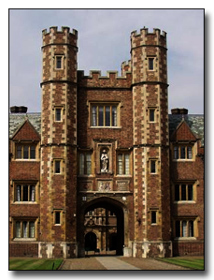 St. John's College: the venue for our Symposium Dinner. |
Almost 150 participants took part in the recent 4th International Materials Education Symposium, held at Cambridge University. Speakers included university professors, lecturers, and government policy-makers. With two days devoted entirely to materials education across science, design, and engineering, participants were keen to discuss their experiences of teaching materials, share resources, and network with those across the disciplines covered.
Presentations and posters covered a wide range of subjects falling broadly into four categories:
- Innovation and Change
- Advanced Teaching, Research, Government, and Industry
- Crossing Disciplines
- International Perspectives
The Symposium not only offered two days of presentations, but also discussion sessions, posters, and a social program. “I’m among friends”, enthused Mark Miodownik (Kings College London), enjoying the opportunity to talk about materials innovation and the best ways to inspire students. The collaborative atmosphere was established early on, as the presenters enjoyed a candle lit dinner in the beautiful hall at Magdalene College on the night before the first session. The next evening, St. John’s College’s 16th century Hall provided the perfect setting for participants to relax and continue the discussions which had started in the lecture theatre and poster hall, as they enjoyed the Symposium Dinner.
Symposium Report
The 4th International Materials Education Symposium got off to a great start this year, Bill Clyne (Cambridge University) used practical demonstrations of unstable crack growth in balloons to give an explosive start to proceedings. The event drew inspiring speakers from right around the globe (the UK, Switzerland, and Australia were represented on the first morning alone). Engaging and inspiring students ran as the sub-text through the event: attendees were certainly inspired from the very start of the first session, chaired by Peter Goodhew (University of Liverpool), looking at ‘Innovation and Change’. Speakers offered practical tips on how to run meaningful practical demonstrations in lectures, flagged the difficulties of encouraging depth of learning, and discussed the pros and cons of online teaching. One thing came out loud and clear—“students revel in a challenge”. For example, Mervyn Jones (Imperial College London), described how student-run engineering projects in third-world countries, are leaving a lasting impression on those involved.
The afternoon session, chaired by Yves Bréchet (Grenoble Institute of Technology), on ‘Advanced Teaching, Research, Government, and Industry’, encouraged educators to embrace not just ideas about materials science, but to put in place the right infrastructure of people and programs. Cyrus Wadia (The White House) described how a major US government initiative, the Materials Genome Initiative, is pushing for a paradigm shift in both the way that materials are taught and in industrial R&D. It aims for an increase in innovation, getting new discoveries into the marketplace in half the time and for half the cost. Continuing with this theme, Frank Stefan Becker (Siemens AG, Germany) emphasized how forging links between the industry and academia is already bearing fruit, equipping young people with the competencies they need in their professional life. Brian Magee (Queen's University Belfast) reinforced this from the academic viewpoint. He provided a truly inspiring talk on concrete (a material that no participant could ever now accuse of being “as dull as its color”!), and how teaching in this area is fostering ‘industry-savvy students’.
The ensuing discussions demonstrated a growing sense that universities must challenge students in order to inspire them. After all, they will shed blood, sweat, and tears on the university sports fields, but not quite the same in the lab. What sort of vision will capture their hearts? For many, environmental and sustainability issues are giving students the sense that they can do something to change the world. Seeing the real-life applications of their work is important: students tend to listen to those in industry, and apply themselves where they can see a practical outcome.
Sharing resources that can foster these opinions is a key step—we saw many examples across the Symposium such as CORE-Materials, Granta’s Teaching Resources Website, and the new Spanish IdM@ti collaboration. As one participant commented, the caricature is that "an academic is more likely to share his toothbrush with his colleagues than his lecture notes", but this event goes a long way to proving that times are changing. The community are coming together to help ensure that today’s students receive the best possible education, and one that is very much focused on real-world application and skill-sets.
The second day expanded on the collaborative themes as Noel Rutter (Cambridge University) chaired the session on ‘Crossing Disciplines’. The future of materials science and even materials engineering will no longer allow these subjects to be taught in isolation. Crossovers between branches of engineering, and into broader disciplines such as biology and design, are essential. As is teaching the skills which will sustain the thought-leaders of tomorrow. More than that, it became clear that we cannot separate materials innovation from both application and the people these materials will impact. Mark Miodownik (Kings College London) demonstrated how engaging with the public can revitalise enthusiasm on both sides, raise new research questions, and will certainly help to inspire students (see 'The Institute of Making'). ‘Crossing Disciplines’ must mean teaching the human and cultural side of materials alongside their physical properties and application.
Culture was also a key interest on the final afternoon, as Hugh Shercliff (Cambridge University) chaired the session on ‘International Perspectives’. For example, many European courses are relying more and more heavily on self directed learning, but this isn’t something traditionally taught in China. However, many Chinese students have incredible drive and motivation, and are very well grounded in maths, physics, and chemistry. Awareness of such differences is important not just when designing resources to be used in other cultures, but in every classroom of our increasingly multi-ethnic universities.
During the concluding presentations, participants were encouraged to think about some of the tools they are using in their teaching. Sybrand van der Zwaag (TU Delft) provided fascinating statistical analysis of the content of leading materials text books—set, tongue-in-cheek, in the context of designing a new text on ‘speed skating from a materials perspective’—encouraged audience participation and gave hard-hitting insights. Attention also focused on the growing number of innovative online teaching materials, from YouTube and Flicker to dedicated materials resources like DoITPoMS.
The official proceedings drew to a close with a lively discussion on how to balance depth and breadth of teaching, how to encourage enthusiasm, and how to assess progress without stifling curiosity. Drawing on the many practical suggestions and inspiring examples presented throughout the event, those present were extolled to give students confidence in what they do and don’t know, to teach them where to look for what they need to know, and to inspire them to see how and why this materials knowledge really matters.
Posters and Courses
The discussions in the main lecture theatre continued across the breaks and social program, but were particular stimulating during the poster sessions. This year, new 'Poster Teaser' sessions provided opportunities for delegates to hear about out what is working—and what is not!—across the disciplines represented. Each poster presenter was invited to give a 60 second introduction to their work: these snap-shots caught people's interest, and led to lively discussions and sharing of ideas.
The short courses in the use of CES EduPack on the two days preceding the symposium, led by Mike Ashby, also received positive feedback, with many participants benefiting from the time to interact with the software and work through case studies and the new developments within the 2012 version.
Following the close of the official proceedings, many people took the opportunity to explore Cambridge, either joining the walking tour or punting trip on the Cam (more pictures at the foot of this page).
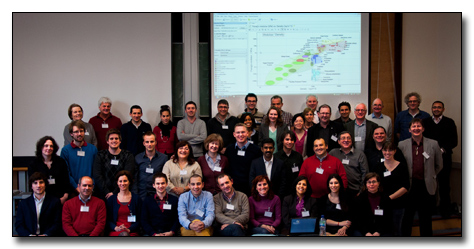
Short Courses were held at the Cambridge University Engineering Department
on the two days preceding the International Materials Education Symposium.
Thank you
We would like to thank all those whose presentations and contributions made the 4th International Materials Education Symposium such an interactive and collaborative event—and hope to see you again in 2013! This key event was coordinated by Granta Design with support from an independent academic Advisory Committee;
- American Society for Engineering Education (ASEE), Materials Division;
- ASM International (the Materials Information Society);
- California Polytechnic State University (Cal Poly);
- European Society for Engineering Education (SEFI);
- Federation of European Materials Societies (FEMS);
- The Minerals, Metals & Materials Society (TMS);
- University of Cambridge (Department of Engineering and Department of Materials Science & Metallurgy).
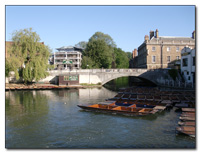 |
 |
 |
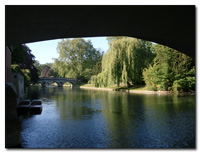 |
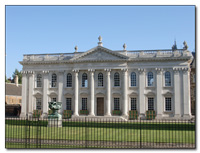 |
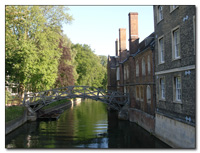 |
